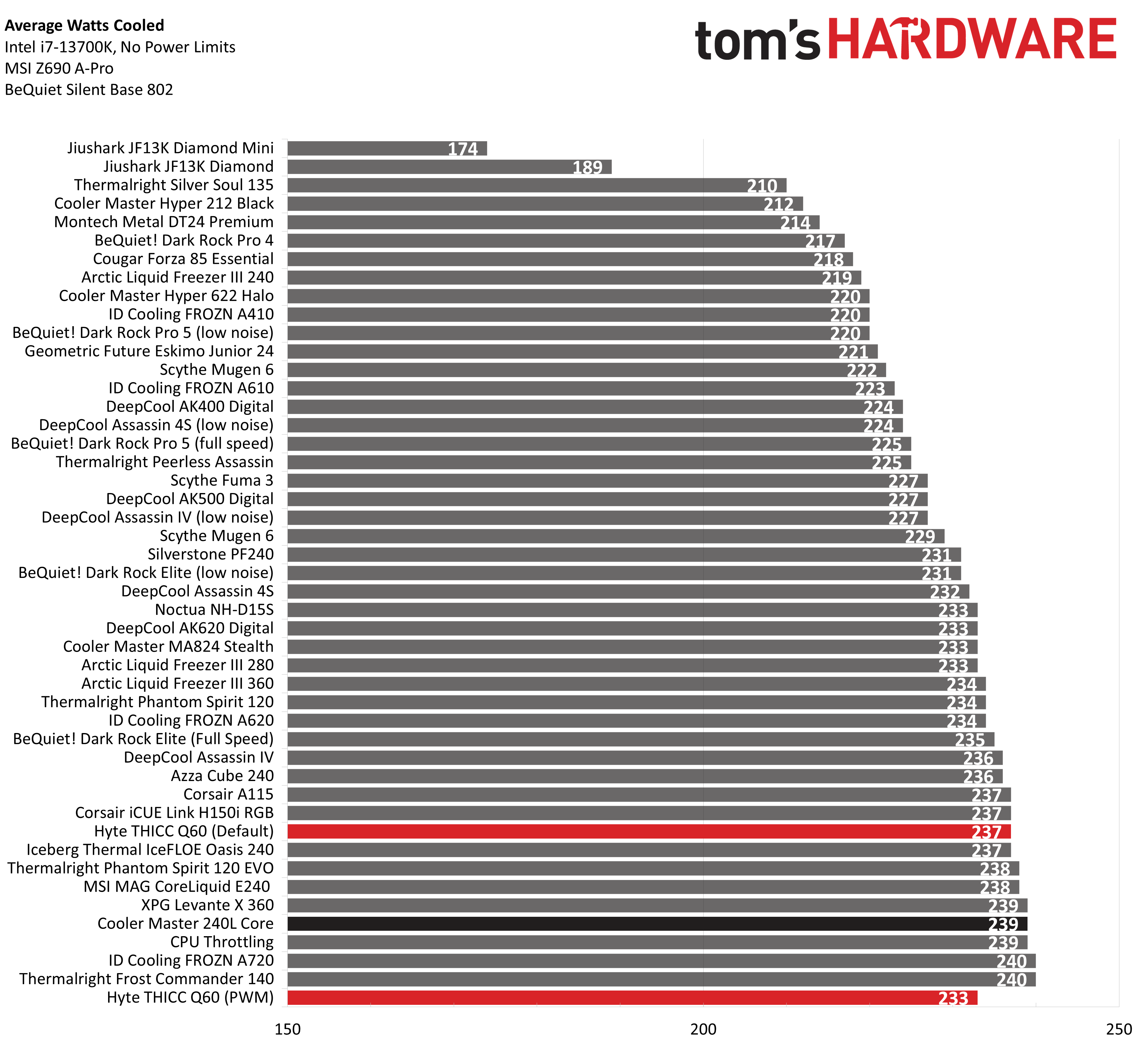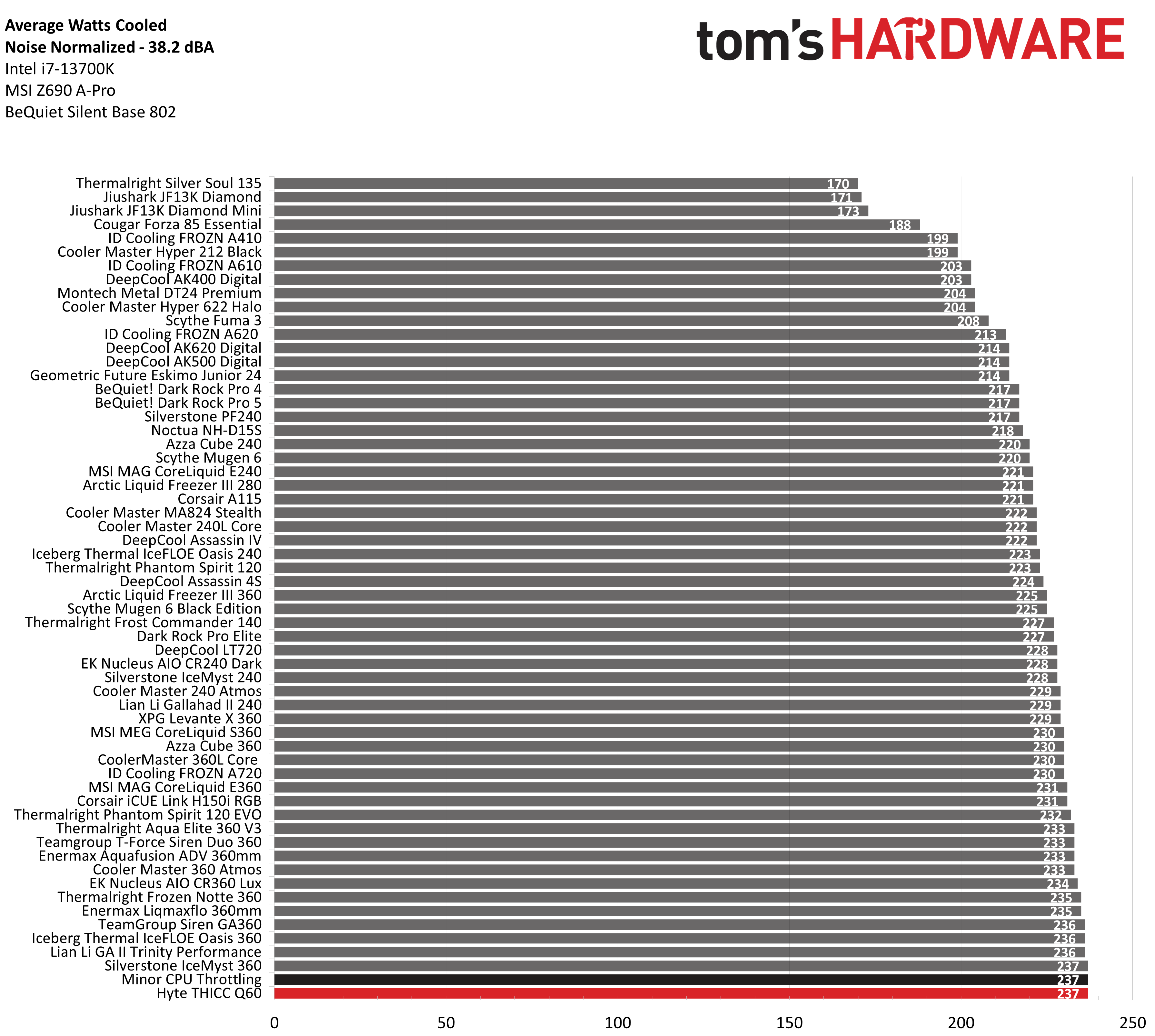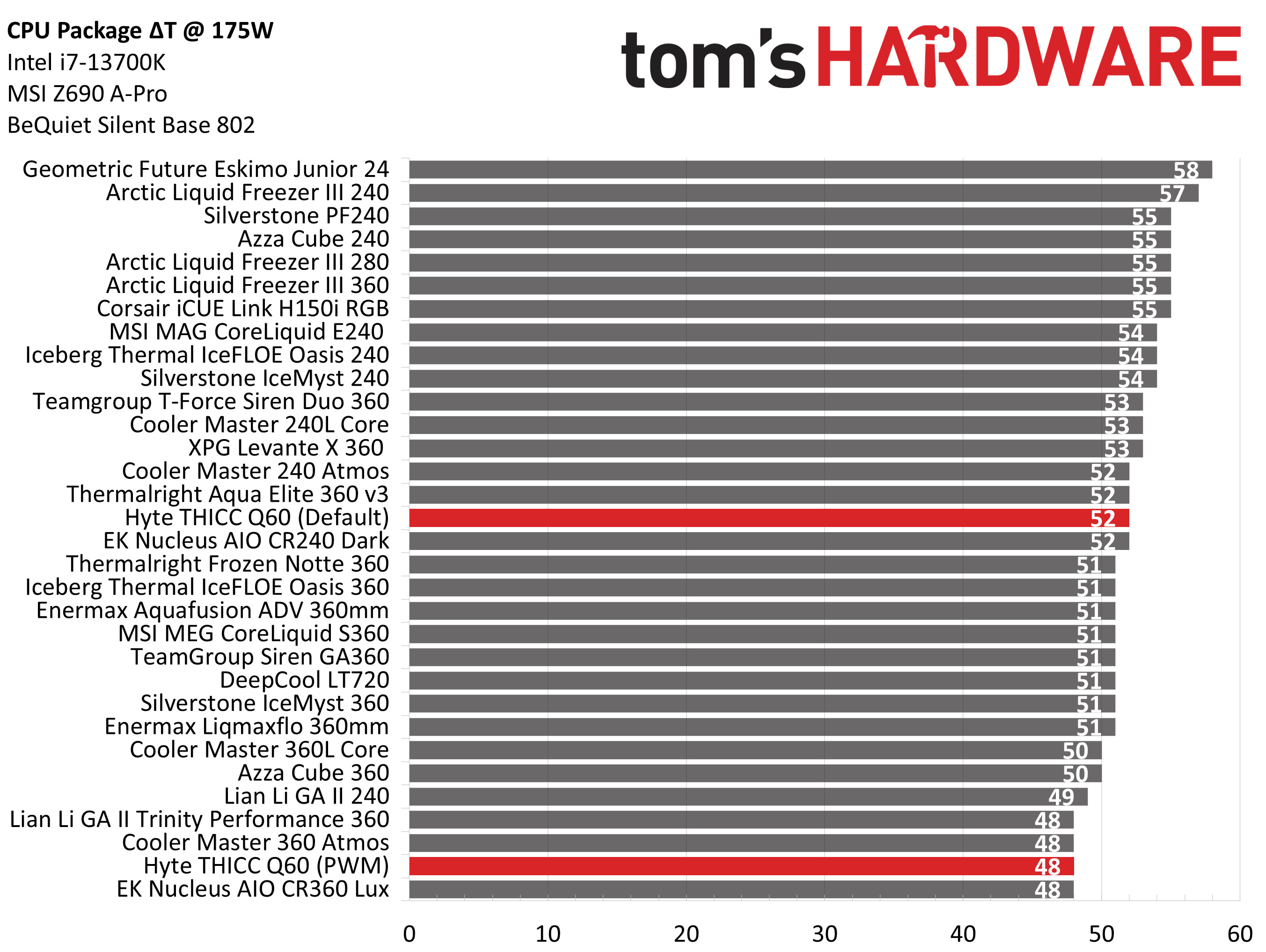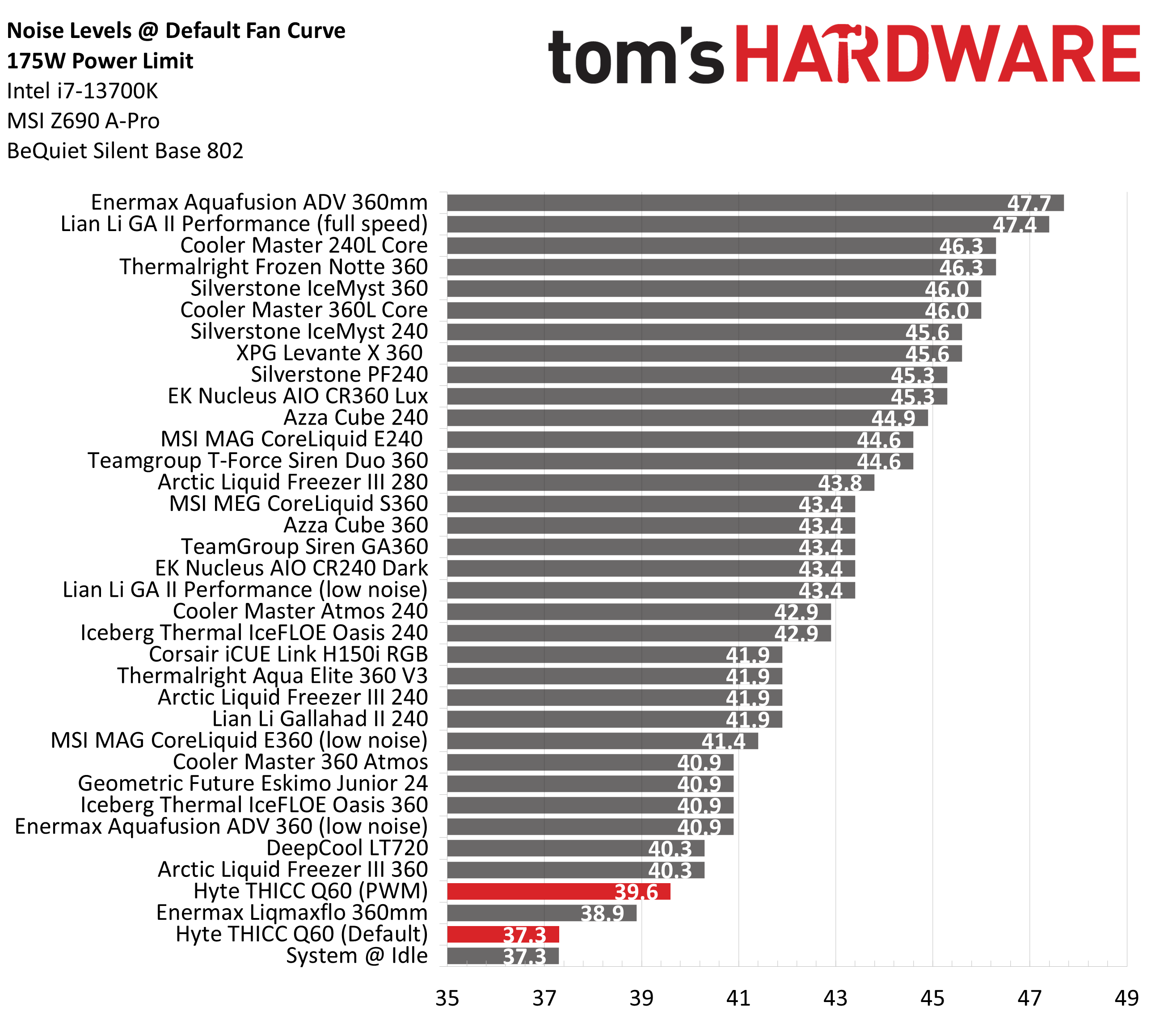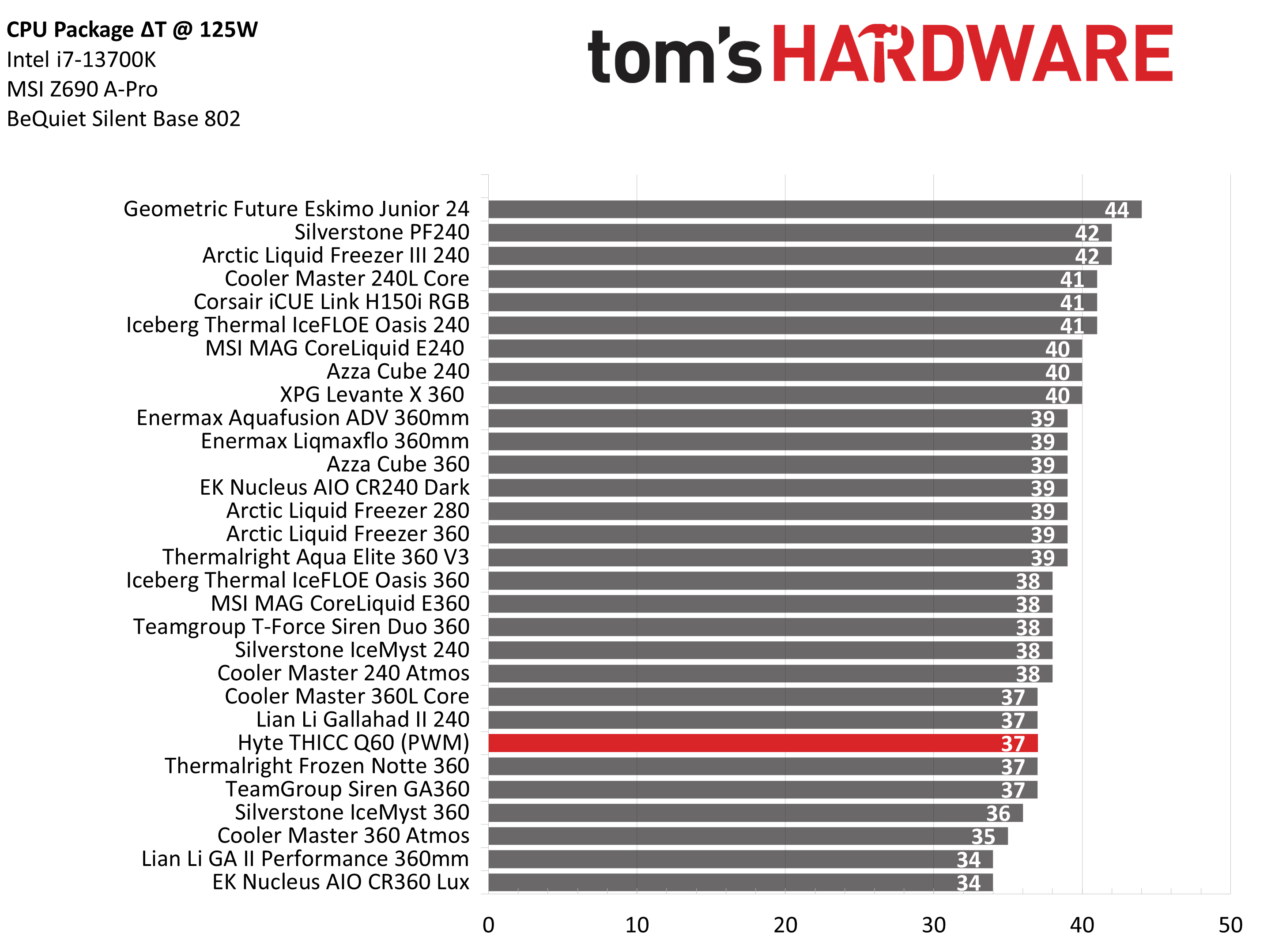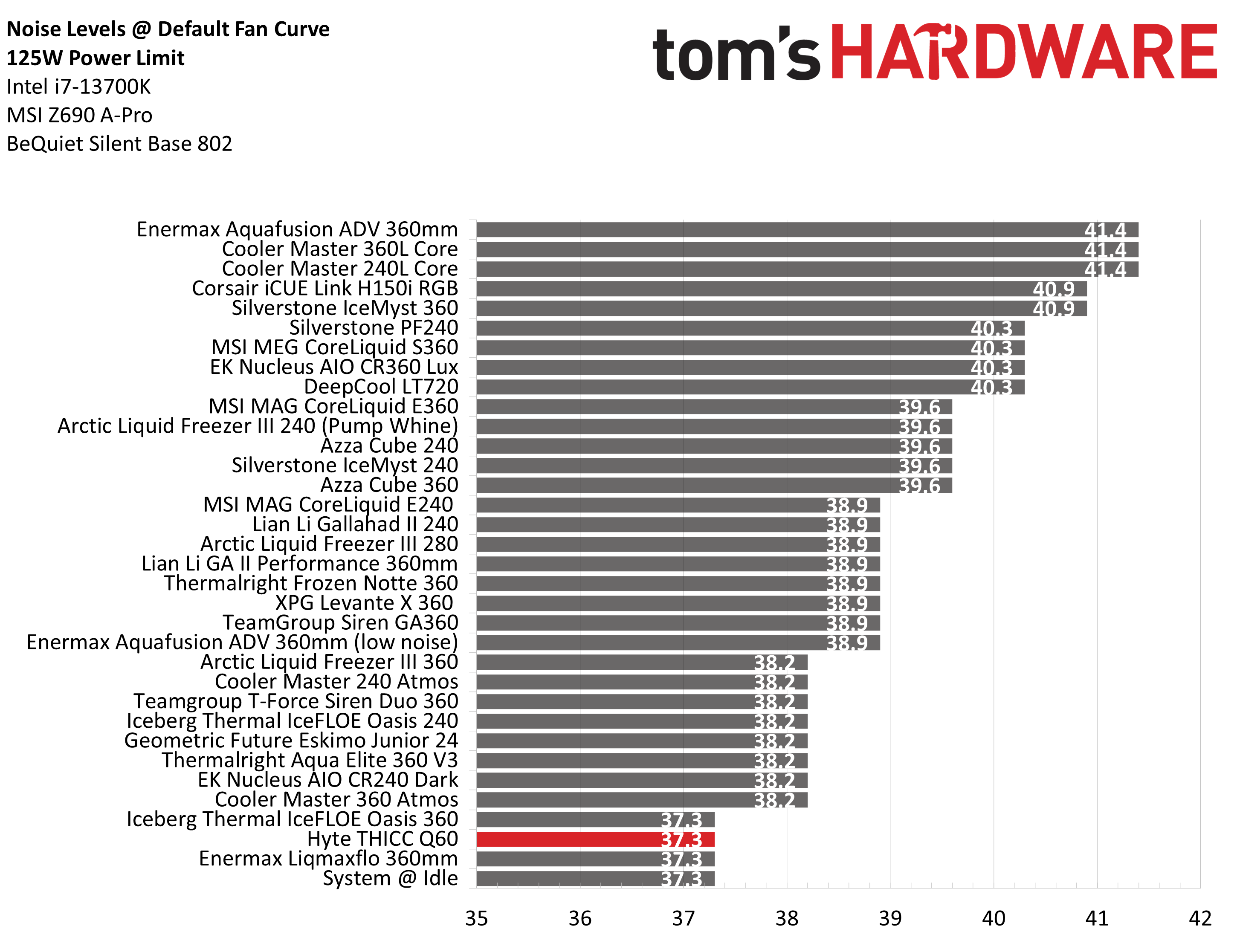Why you can trust Tom's Hardware
Thermal results without power limits
Without power limits enforced on Intel’s i7-13700K, the CPU will hit its peak temperature (TJMax) and thermally throttle with even the strongest of air coolers. When the CPU reaches its peak temperature, I’ve measured the CPU package power to determine the maximum wattage cooled to best compare their performance.
The general exception to this comes with the strongest AIOs on the market, which can keep Intel’s i7-13700K under TJMax. This is no small task, as most 360mm AIOs still fail this test.
The thermal results here are absolutely insane for a “240mm” AIO. With an average temperature of 88 degrees C, Hyte’s Q60 outperformed nearly every cooler I’ve ever tested – with the exception of Lian Li and Cooler Master’s flagship 360mm AIOs.
Note, though, for this cooler to achieve these incredible thermal results, you’ll have to manually change the settings. Its default configuration pump and fan speeds are tied to the temperature of the AIO’s liquid coolant, rather than the temperature of the CPU. This is good for lower noise levels and causes it to run very quietly, but prevents it from running as cool as possible during intense workloads.
To illustrate the performance when the pump and fans run at their very quiet default settings, I’ve measured the average power consumed by the CPU. In its default configuration, the Hyte Q60 cools 237W. This causes extremely minor CPU throttling of 100 MHz on a few of the cores, but realistically the benchmark performance would be impacted by less than 1% in that situation.
You’ll notice this maximum watts chart has the Hyte THICC Q60 in two positions. The first shows the default configuration. The second shows its performance in PWM mode. So why did we list the PWM performance of 233W listed ahead of the 237W default configuration performance?
That comes down to electrical leakage. Lower temperatures reduce electrical leakage, which in turn reduces power consumption. This is a phenomenon most commonly observed in power-hungry GPUs that are paired with strong liquid cooling. An example of this from another reviewer is when Nathan Kirsch of Legit Reviews tested NZXT’s Kraken G10 + X40 AIO on a Radeon R9 290X GPU and observed a drop of 44W in power consumption.
Get Tom's Hardware's best news and in-depth reviews, straight to your inbox.
A power consumption drop from the maximum of 240W to only 233W is rather minor, a 3% difference overall – but it is worth noting to demonstrate exactly how strong this cooler can perform.
Still, these results don’t tell the entire story. Noise levels are just as important as total cooling performance.
Hyte’s THICC Q60 has the curious distinction of achieving both the best and worst results from any AIO liquid cooler that I have tested so far. In its default configuration, it runs at only 38.2 dBA under maximum thermal load – barely louder than my system’s noise levels at idle and over 4 dBA quieter than Arctic’s Liquid Freezer III 240.
But if you let the fans run at full speed to showcase its total thermal domination, it is quite the opposite story. With a measurement of 56 dBA, the Q60’s unrestricted fans are the loudest I’ve tested. One thing I’d add, however, is that the pitch of the fans is pleasant – making them sound quieter than the noise measurement would indicate. However, the impact of pitch is subjective and your preferences may vary from mine.
Thermal results with noise normalized to 38.2 dBA
Finding the right balance between fan noise levels and cooling performance is important. While running fans at full speed can improve cooling capacity to some extent, the benefits are limited and many users prefer a quieter system. With this noise-normalized test, I’ve set noise levels to 38.2 dBA. This level of noise is a low volume level, but slightly audible to most people.
The THICC Q60’s noise-normalized performance is so much better than anything I’ve ever tested, it really isn’t comparable to the rest of these results. You’ll notice the black bar above the Hyte’s results, indicating “minor CPU throttling”. When I’ve done my previous testing at 38.2 dBA, every cooler I’ve tested, both liquid and air, had some level of CPU throttling.
Hyte’s THICC Q60 did not, allowing the CPU to maintain its maximum turbo speeds throughout testing. We have a new king of quiet cooling on the market.
175W Cinebench results
Most modern coolers can keep Intel’s i7-13700K under its peak temperature if the power consumption is limited. So for this test, we’ll be looking at the CPU’s actual temperature.
In its PWM configuration, Hyte’s THICC Q60 ties for the best thermal results we’ve seen from any cooler in this 175W test. Unlike the maximum strength test, the fans don’t get very loud while tied to my motherboard’s default fan curve in PWM mode – only reaching 39.6 dBA. Of all the liquid coolers I’ve ever tested, only the Enermax LiqMaxFlo 360 runs quieter here.
If you’re particular about low noise levels though, you can just run the cooler in its default configuration. The CPU will run 4 degrees hotter, but the default configuration pretty much eliminates extra noise. The measurement I recorded in the default configuration is 37.3 dBA, the same measurement of my system at idle. What this means is that (in its default configuration) Hyte’s THICC Q60 runs quieter than my system fans do, and that most users will never observe increased noise levels from this cooler in a moderately strong workload.
125W Cinebench results
The lowest power limit I test with Raptor Lake CPUs is 125W. This is a high enough limit to allow the CPU to maintain its base clock speeds even in the most intensive tests, and most coolers should be capable of keeping the CPU below TJ Max (the max temperature before throttling) – even low-end coolers.
Really, thermals do not matter in this scenario. Even Intel’s stock cooler can handle a load like this with ease. Noise levels, rather than CPU temperature, are the most important factor here. Hyte’s Q60 has perfect noise levels in this test, measuring only 37.3 DBA – meaning that the cooler ran quieter than the sound of my system fans. These noise levels are only matched by two competitors, Iceberg Thermal’s IceFLOE and Enermax Liqmaxflo AIOs.
Conclusion
The performance of Hyte’s THICC Q60 utterly dominates the competition in every metric. It has the lowest noise levels of any AIO I’ve tested in common workloads, especially in its default configuration. When acoustics were noise-normalized to a low 38.2 dBA, its performance was the best I’ve tested of any cooler, strong enough to keep Intel’s i7-13700K running at its maximum turbo speeds. No other cooler on the market is capable of doing this.
The biggest problems that the Hyte THICC Q60 faces are compatibility concerns. It will not fit in many cases while top-mounted. Most users will have to install this cooler in a front- or side-mounted configuration.
If you need powerful cooling, have the budget for a cooler that costs $299 USD, and the case compatibility to fit it, the Hyte THICC Q60 cooler is highly recommended. It’s the best AIO liquid cooler on the market in terms of performance and noise levels, and its 5-inch screen and Nexus software give it added capabilities and aesthetics that help it stand out even more. Not everyone needs this level of cooling or features, but if you’re after the best, this AIO is it.

Albert Thomas is a contributor for Tom’s Hardware, primarily covering CPU cooling reviews.
-
NeoMorpheus Always wondered why AIO vendors decided to stay with the 25mm thin radiators.Reply
I’m still rocking an Artic Freezer 120 II AIO which has a 38mm rad and its going strong after almost 5 years.
I remember a custom build in a Cooler Master Elite 120, where the cpu and gpu were cooled with one 120 mm rad, which was also as thick as the one in the article.
And talking about that, would love a mod that uses this rad to cool both the cpu and a gpu. -
Tbonius The cell phone mounted to the thermal block, alone, would be a deal breaker for me. They should sell a version without it, I'm sure it woud be consideraby cheaper.Reply -
Amdlova For me only air coolers... you can find good ones can handle 170 180w for 35/40 bidens.Reply
Got one Sl-100 to cool the ssd and vrm all same time. On a 35w cpu gives 2°c over ambient temps.
And noise? Barely audible at 5cm -
Albert.Thomas Reply
I agree, and I've given them the same feedback.Tbonius said:The cell phone mounted to the thermal block, alone, would be a deal breaker for me. They should sell a version without it, I'm sure it woud be consideraby cheaper. -
mwm2010 I wonder if any SFF builds will use this in the future. I think this is really cool(pun intended).Reply -
LabRat 891 ReplyTbonius said:The cell phone mounted to the thermal block, alone, would be a deal breaker for me. They should sell a version without it, I'm sure it woud be consideraby cheaper.
I'm tempted to tape my Pixel 4a to the top of my (dead/noisy) H100i v2...
"JUST AS GOOD" :LOL: -
thestryker The design of this cooler has been interesting from the start, and I can't imagine it's cheap to produce. While I despise the screen and that would prevent me from buying it I'm not sure how much cheaper removing it would make things. The radiator is still a custom design, has dual pumps and custom fan design while the screen is just a low res 60hz panel. I'd imagine their marketing determined adding the screen would make people more likely to drop that kind of money on an AIO.Reply
I am really glad to see something with a unique design in this market (that also performs extremely well) and hopefully we'll continue to see more. -
crunchylayer4 Would like to see a 140mm wide version. A larger fan at a lower rpm should be slightly quieter. Push-pull fan configurations could also run at lower rpm to maintain similar flow to high rpm fans.Reply -
rockerrb3 We need an exact list of all the cases that will work with this cooler. The NZXT cases seem to be the most popular.Reply -
Albert.Thomas Reply
Well, it kinda depends how you mount it. Hyte expects that most users will front mount the THICC, and its compatible with many cases that way. If you top mount it though, that's where compatibility really is a concern!rockerrb3 said:We need an exact list of all the cases that will work with this cooler. The NZXT cases seem to be the most popular.


